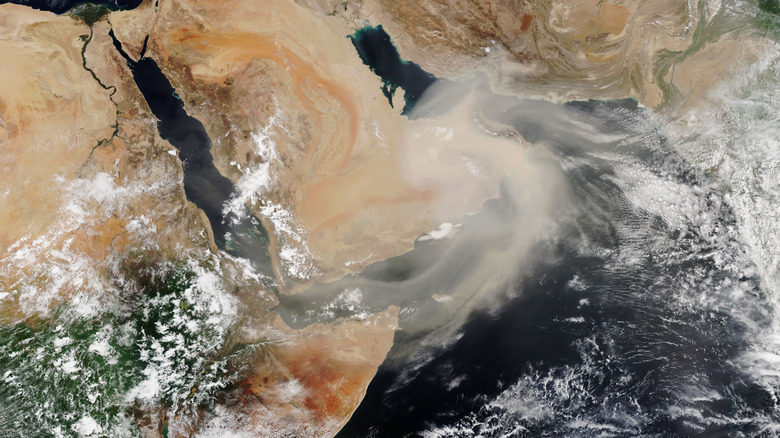Why NASA Is Measuring Dust On Earth From Space
Space agencies like NASA have an ongoing fight with a tiny enemy: dust. From Martian dust covering up the solar panels of Mars landers like InSight and rovers like Opportunity to tricky sharp moon dust that gets into components and eats away at them, the problems presented by these small particles are many. But NASA isn't only interested in dust out in the depths of space — the agency is also interested in the dust right here on Earth. As part of its suite of Earth monitoring tools and experiments, NASA will soon be launching an experiment to the International Space Station (ISS) to measure dust in Earth's atmosphere.
The Earth Surface Mineral Dust Source Investigation (EMIT) instrument analyzes dust using a spectrometer, an instrument that breaks light down into a spectrum to see the composition of targets (via JPL). This allows it to pinpoint particular minerals in dust, and so see what the dust is made of.
The idea is to point the instrument at Earth and to study desert regions in particular, as these are the sources of a large amount of mineral dust in the atmosphere. According to NASA, the total amount of mineral dust carried out of desert regions and into the atmosphere is an incredible amount at more than a billion metric tons per year. Researchers want to measure how this dust moves through the atmosphere and what effect it has on the climate.
Effects of dust on the global climate
With the issue of climate change ever more pressing, scientists want to know if the dust is exacerbating the problem. Researchers know that climate change is causing more frequent dust storms (via Atmospheric Environment) and that it contributes to other hazardous weather events like sand storms as well. However, trying to understand the overall effect of dust on the climate is complicated.
Dust can have complex effects on temperature extremes, as explained by a study published in Frontiers in Earth Science, and researchers aren't exactly sure how having more dust around will affect the climate. It could be that different types of dust have different effects, and some could reflect heat from the sun and help to cool the planet, while others could absorb the heat and contribute to warming. That means it's hard for researchers to predict the role of dust in climate change, according to UCLA.
That's why EMIT is being used to measure types of dust, to see if they are darker types that absorb heat or lighter colored types which reflect it. Gathering this data will help scientists see how dust is affecting the climate now, and also to predict how it will affect the climate as it changes in the future. "By incorporating EMIT's global dust source composition data into models and predictions, scientists will gain a better understanding of how the amount and composition of dust in arid regions may change under different climate and land-use scenarios," NASA explains. The EMIT instrument is scheduled to launch for the International Space Station on June 9, 2022.
